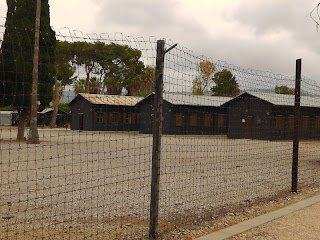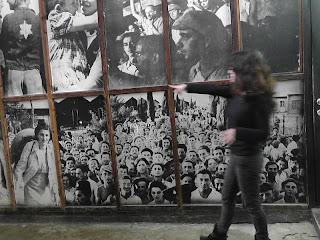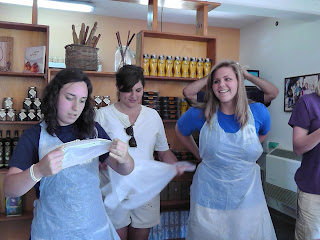This was our first view of the day...I know it doesn't look like much because it was hazy, but we climbed way up high onto the Golan Heights and are now looking down on the Sea of Galilee. We could see the entire Sea from up here!! The little village you see on the shore is En Gev, the resort we were staying at for 2 nights. It was an amazing view, we could see Bethsaida, Capernaum, Safed, Tiberius, etc. all from that lookout.
Here we are at a location where we stopped beside the road to have a look at 3 countries at the same time. The near hill on the left is Israel (Golan), the middle hill is Syria, and the far hills on the right are Jordan!
Another view of borders from Mount Bental. These soldiers are looking over the land. From here we can look straight into Syria. There is a big military lookout base on the next hill over. Mt. Bental is an extinct volcano.
Also from Mt. Bental...blow this picture up and you will see the snowy peaks of Mt. Hermon. Its summit straddles the border of Syria and Lebanon.
The next border we went to was Metulla, in Northern Israel. We sat up here, looking over the city of Metulla, and Lebanon is right behind it. That hill behind the homes is in Lebanon, and is Hezbollah territory. We sat up here for about an hour while our professor lectured us about the history of conflict between Lebanon, Hezbollah and Israel. Here is a news blurb I saw about Metulla a couple days after we were there:
Metula's security wall offers protection from Hezbollah
Metula, the most northern town of Israel, susceptible to Hezbollah attacks by virtue of its location only six kilometers from the Lebanese border, is receiving increased security and protection by the IDF. A security wall over one kilometer in length and 5-7 meters high is under construction to protect the approximately 1,500 Israelis living in Metula. It is being built in coordination with the UNIFIL peacekeeping force in southern Lebanon, who has notified the Lebanese army. The IDF Spokesman's Office said in a statement on Monday that the barrier will serve to reduce tensions and improve security in the area.

This is a map at a museum at Hanita, that shows the many settlements that were developed in the 1930's just before Israel became a state. Back then, it was not yet decided where the borders would be, and the thought was to go ahead and settle in these areas because where the Jews lived would actually determine the borders of Israel. The people that settled these villages risked their lives, especially during the Arab revolt of 1936-1939 and many lost their lives defending their homes and families.
The pioneering Jews had a system called "Tower and Stockade", where they would go into land that had been legally purchased for them, and within 24 hours set up a fence (stockade) and a lookout tower for defense. By nightfall it was not unusual to be attacked by bands of Arabs. These settlements were built pre-fab elsewhere, and trucked into the areas where they wanted to settle. This is a little model of the tower and stockade concept.
Boots of a Jewish pioneer who worked to build Hanita, a kibbutz, in 1939. 10 men lost their lives as it was being built in what would become Northern Israel.
We are at the present-day kibbutz of Hanita, looking at the border fence of Lebanon. The truck you see is in Lebanon.
This hill is in Lebanon, and if you look really close, you can see a Hezbollah lookout tower on top of it. (Hezbollah is a Shi'ite Muslim militant group and political party in Lebanon, that may soon take over their political system, which would not be good news for Israel).
And here's one of Israel's lookout/survelliance towers on the Lebanese border.
Walking back to the bus, we are walking amongst brand new houses being built for residents of Hanita. It seemed amazing that these people are choosing to live right on the border, so close to a militant anti-semitic terrorist organization. They believe they are helping to protect Israel's borders by doing so, and their families have been there since the 1930's.
Now we are on the coast of the Mediterranean, at a prison museum at Akko where members of the Zionist underground resistance were imprisoned by the British during the British mandate (in the 1930's and '40's). These statues are showing a prisoner checking in. They were members that were resisting the British and wanting to establish a Jewish homeland.
Here's the prison courtyard where the prisoners were let out once a day and allowed to walk in a circle, two by two, for a few minutes of exercise.
The prisoners slept on mats on the floor, woven from pieces of cloth. They used to hide contraband in the mattresses, even explosives, and once were able to effect a prison breakout. Many escaped, but several died during the breakout. Their crime was being Jewish and wanting independence from Britain, and freedom from the Arabs who tried to kill their families.
This represented the little room used as a synagogue in the prison.
These are just 3 of the men who were hung in this prison. Reading their stories made it all seem so real (well, it IS real). Young idealist Jewish men who fought bravely for their right to a homeland, safe from the Nazis and others that persecuted them. Nine ended up being executed right here.
This is the little window visitors would come to, to visit someone on death row.
This is the same room they were executed in, by hanging. The trap door, the rope, etc. was all so sobering. The Hebrew words on the wall are the names of the nine men who died here.
Driving through Haifa, also on the coast...I took this pic out the window of the bus. Looking down this street you can see the Bahia Gardens up on the hill.
We had a 'bus lunch', where we just ate out the side of the bus. Pita bread (it was cold and half frozen), hummus, cheese, carrot sticks, whatever we could find in there. Peter is hungry enough to eat it:)
Now we are at Atlit, a museum that once was an Illegal Immigrant camp for Jews that came to Israel 'illegally' when the British had control. In the late 1930's they severely limited the numbers of Jews that could come (due to pressure from the Arabs), yet tens of thousands of Jews were still trying to flee from Europe and Russia and from the holocaust. Most came by ship, and were taken to these camps to be detained.
A ship similar to the ones that brought the Jewish immigrants to Israel. They were crowded and crammed as many people on them as possible.
These are actual boards from the bunkers where the immigrants stayed...they would carve in their names, say where they were from and where they'd be taken. Hoping their lost family would find them. You may need to click on this to enlarge it to see. Someone even carved a pic of the ship they came over in.
The guide is showing us a spray cannister that was used to de-louse the immigrants, and she standing in front of a big washing maching where their clothes would be laundered when they first got there. The extreme heat would shrink their clothes, and they would no longer fit so they'd have to exhange them with someone else smaller. Can you imagine coming from a concentration camp to Israel, then the first thing they do is make you undress, spray you down, and make you get in a shower? It was terrifying for them I am sure. But the end result was that most of them did get to stay in Israel and eventually become citizens of the new Jewish state.
Here she is pointing to actual photographs of the immigrants at this camp. They look pretty happy to me, once they figure out this is NOT a concentration camp.












































